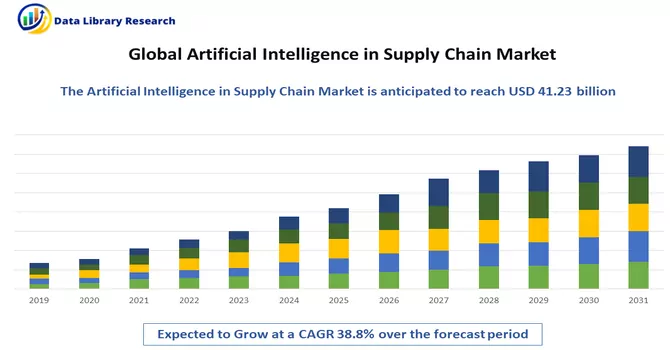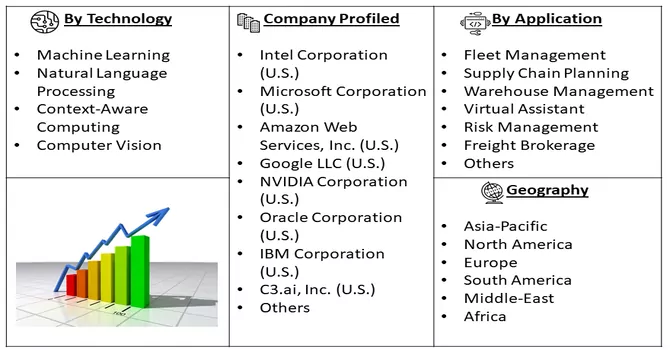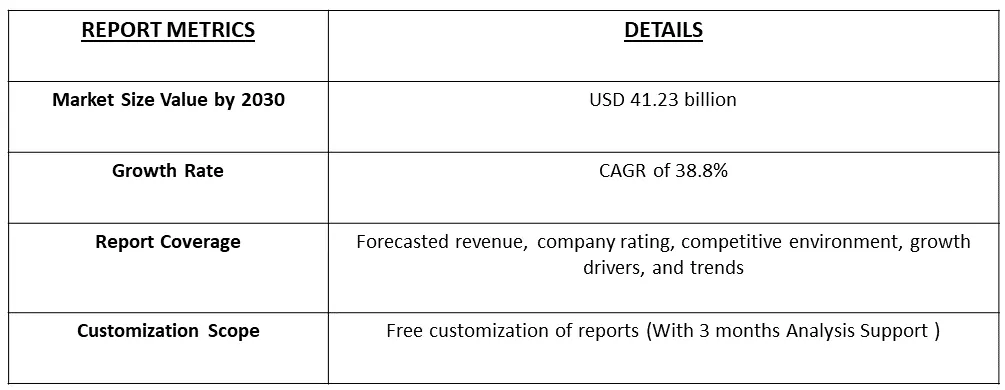The AI in Supply Chain Market is projected to reach $41.23 billion by 2030, at a CAGR of 38.8% during the forecast period of 2023–2030.

Get Complete Analysis Of The Report - Download Free Sample PDF
The growth of the AI in supply chain market is driven by the increasing incorporation of artificial intelligence in supply chain operations and the rising need for greater visibility and transparency in supply chain processes. However, high procurement and operating costs and the lack of infrastructure restrain the growth of this market.
The global supply chain industry is experiencing a significant transformation due to the integration of Artificial Intelligence (AI) technologies. AI is revolutionizing supply chain management by enhancing operational efficiency, predictive analytics, and decision-making capabilities.
AI-driven automation and predictive analytics optimize supply chain operations, reducing errors and costs. AI technologies streamline processes, such as demand forecasting, inventory management, and route optimization.
AI enhances visibility throughout the supply chain. This transparency enables rapid response to disruptions, better risk management, and improved tracking of products in transit. AI can identify cost-saving opportunities by optimizing routes, reducing waste, and automating routine tasks. This leads to significant cost reductions in supply chain operations.
Market Segmentation:
AI technologies are improving procurement processes by optimizing supplier selection, negotiation, and contract management. The use of AI-driven autonomous vehicles and drones for deliveries and transportation is on the rise. These technologies are expected to further optimize logistics and reduce delivery costs.

For Detailed Market Segmentation - Download Free Sample PDF
Drivers:
Increasing Incorporation of AI in Supply Chain Operations to Enhance Customer Experience and Satisfaction
The increasing integration of AI in supply chain operations is having a profound impact on customer experience and satisfaction. The market for AI in the supply chain is witnessing significant growth and diversification, driven by the need for more efficient, transparent, and sustainable supply chain processes. As AI technologies continue to evolve, businesses that harness the power of AI in their supply chains are likely to see improvements in customer loyalty and overall satisfaction, ultimately contributing to their competitive edge in the market. AI technologies are rapidly advancing, offering more sophisticated predictive capabilities and decision-making support, which further enhances their role in supply chain optimization.
High Procurement and Operating Costs Limiting the Adoption of AI-based Supply Chain Solutions
The initial costs associated with acquiring AI-powered supply chain solutions can be substantial. Companies, especially small and medium-sized enterprises (SMEs), may find it challenging to allocate resources for such investments. AI has the potential to revolutionize supply chain operations, high procurement and operating costs present a significant barrier to adoption. Addressing these cost challenges will be crucial for a more widespread and inclusive adoption of AI-based supply chain solutions, ultimately driving further growth and innovation in the AI Supply Chain Market. Thus, the market is expected to witness significant growth over the forecast period.
Restraints:
Data Privacy and Security Concerns and High Implementation Costs
AI relies on vast amounts of data, and concerns about data privacy and security vulnerabilities continue to be a challenge. Ensuring the protection of sensitive supply chain data is imperative. The initial investment required for AI adoption in the supply chain can be substantial. Smaller enterprises may find it challenging to implement AI solutions. Thus, the growth of the market is expected to slow down over the forecast period.
The COVID-19 pandemic highlighted the need for resilient and adaptable supply chains. AI played a crucial role in responding to disruptions, optimizing routes for medical supplies, and providing insights into changing consumer demands. The pandemic accelerated AI adoption in supply chains, emphasizing the importance of digital transformation for supply chain resilience. In conclusion, the "Artificial Intelligence in Supply Chain Market" is experiencing significant growth due to its ability to enhance efficiency, improve inventory management, and provide predictive analytics. However, challenges related to data privacy, implementation costs, and integration complexity must be addressed. As AI technologies continue to evolve and regulations adapt, the market is expected to witness substantial developments in the coming years.
Segmental Analysis:
Machine Learning Segment is Expected to Witness Significant Growth Over the Forecast Period
ML algorithms analyze historical sales data, market trends, and various external factors to provide accurate demand forecasts. This enables businesses to optimize inventory levels, reduce stockouts, and meet customer demands more effectively. The use of AI and ML in the supply chain market is leading to more efficient, transparent, and responsive supply chain operations. These technologies are invaluable in addressing challenges, improving decision-making, and optimizing every aspect of the supply chain, from forecasting to delivery. As they continue to evolve, AI and ML are set to play an even more significant role in shaping the future of supply chain management. Thus, the segment is expected to witness significant growth over the forecast period.
Cloud-based Deployments Segment is Expected to Witness Significant Growth Over the Forecast Period
Cloud-based deployments and the use of Artificial Intelligence (AI) in the Supply Chain Market are driving a significant transformation in supply chain management. The synergy between cloud computing and AI is opening up new possibilities for businesses to streamline operations, enhance visibility, and improve decision-making across the supply chain. Cloud-based AI solutions offer scalability to meet the growing needs of supply chain operations. Businesses can adapt to changing demands without the need for extensive infrastructure upgrades. Moreover, cloud platforms provide a centralized repository for supply chain data. AI algorithms can access this data, analyze it in real time, and generate insights for improved decision-making. Thus, the segment is expected to witness significant growth over the forecast period.
Real-time Supply Chain Visibility Segment is Expected to Witness Significant Growth Over the Forecast Period
Real-time supply chain visibility provides a comprehensive view of the entire supply chain, from the sourcing of raw materials to the delivery of the final product to the end customer. The integration of real-time supply chain visibility and AI is revolutionizing supply chain operations. It enhances transparency, optimizes processes, and enables proactive decision-making, ultimately leading to more efficient and customer-centric supply chain management. As these technologies continue to evolve, they will play a crucial role in shaping the future of the Supply Chain Market. Thus, the segment is expected to witness significant growth over the forecast period.
Healthcare & Pharmaceuticals Segment is Expected to Witness Significant Growth Over the Forecast Period
The integration of AI into the supply chain of the healthcare and pharmaceutical industries is revolutionizing the way healthcare products are developed, distributed, and consumed. By improving demand forecasting, inventory management, drug development, and patient outcomes, AI is playing a vital role in enhancing the efficiency and effectiveness of healthcare supply chains. As these technologies continue to advance, they will have an increasingly significant impact on healthcare and pharmaceutical supply chain management.
North America is Expected to Witness Significant Growth Over the Forecast Period
North America stands as a global frontrunner in the seamless integration of Artificial Intelligence (AI) into supply chain management. Businesses across the region have wholeheartedly embraced AI-driven technologies to refine their operations, enhance the customer experience, and guarantee compliance with the ever-evolving regulatory landscape. As AI continues to progress and redefine the boundaries of what's possible, North American supply chains are primed to maintain their leadership in innovation and efficiency within the ever-dynamic world of supply chain management.
Furthermore, the recent developments in the region are expected to witness significant growth over the forecast period. For instance, in April 2023, Oracle introduced new AI and Automation Capabilities to help customers optimize supply chain management. The updates include new planning, usage-based pricing, and rebate management capabilities within Oracle Fusion Cloud Supply Chain & Manufacturing (SCM) and enhanced quote-to-cash processes in Oracle Fusion Applications. Thus, the region is expected to witness significant growth over the forecast period.

Get Complete Analysis Of The Report - Download Free Sample PDF
The AI in Supply Chain Market is highly competitive due to the presence of many major players working in this segment. Some of the key players operating in the AI supply chain market are:
Key Players :
Recent Developments:
1. In June 2023, FourKites, Inc., a prominent player in the supply chain visibility sector, extended its partnership with NFI Industries, a leading third-party supply chain solutions provider in North America. This collaboration aims to offer transportation partners an enhanced level of visibility and more comprehensive data insights. This strategic alliance empowers partners to make informed decisions and continuously enhance their performance, ultimately strengthening customer relationships in the ever-evolving landscape of supply chain management.
2. In June 2023, Vizion, Inc. (U.S.), a supply chain visibility solutions provider, launched an intermodal tracking tool to offer greater supply chain transparency.
Q1. How big is the Artificial Intelligence in Supply Chain Market?
The AI in Supply Chain Market is projected to reach $41.23 billion by 2030, at a CAGR of 38.8% during the forecast period.
Q2. At what CAGR is the Artificial Intelligence in Supply Chain Market projected to grow within the forecast period?
Artificial Intelligence in Supply Chain Market is expected to grow at a CAGR of 38.8% during the forecast period.
Q3. Which region has the largest share of the Artificial Intelligence in Supply Chain market? What are the largest region's market size and growth rate?
North America has the largest share of the market . For detailed insights on the largest region's market size and growth rate request a sample here
Q4. Who are the key players in Artificial Intelligence in Supply Chain Market?
Some key players operating in the market include:
Data Library Research are conducted by industry experts who offer insight on industry structure, market segmentations technology assessment and competitive landscape (CL), and penetration, as well as on emerging trends. Their analysis is based on primary interviews (~ 80%) and secondary research (~ 20%) as well as years of professional expertise in their respective industries. Adding to this, by analysing historical trends and current market positions, our analysts predict where the market will be headed for the next five years. Furthermore, the varying trends of segment & categories geographically presented are also studied and the estimated based on the primary & secondary research.
In this particular report from the supply side Data Library Research has conducted primary surveys (interviews) with the key level executives (VP, CEO’s, Marketing Director, Business Development Manager and SOFT) of the companies that active & prominent as well as the midsized organization
FIGURE 1: DLR RESEARH PROCESS

Extensive primary research was conducted to gain a deeper insight of the market and industry performance. The analysis is based on both primary and secondary research as well as years of professional expertise in the respective industries.
In addition to analysing current and historical trends, our analysts predict where the market is headed over the next five years.
It varies by segment for these categories geographically presented in the list of market tables. Speaking about this particular report we have conducted primary surveys (interviews) with the key level executives (VP, CEO’s, Marketing Director, Business Development Manager and many more) of the major players active in the market.
Secondary ResearchSecondary research was mainly used to collect and identify information useful for the extensive, technical, market-oriented, and Friend’s study of the Global Extra Neutral Alcohol. It was also used to obtain key information about major players, market classification and segmentation according to the industry trends, geographical markets, and developments related to the market and technology perspectives. For this study, analysts have gathered information from various credible sources, such as annual reports, sec filings, journals, white papers, SOFT presentations, and company web sites.
Market Size EstimationBoth, top-down and bottom-up approaches were used to estimate and validate the size of the Global market and to estimate the size of various other dependent submarkets in the overall Extra Neutral Alcohol. The key players in the market were identified through secondary research and their market contributions in the respective geographies were determined through primary and secondary research.
Forecast Model
